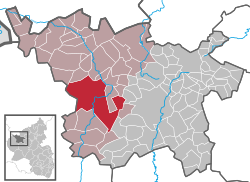Gees (Gerolstein)
| Gerolstein | ||
|---|---|---|
|
||
| Coordinates: 50°13′26″N 6°39′41″E / 50.22389°N 6.66139°ECoordinates: 50°13′26″N 6°39′41″E / 50.22389°N 6.66139°E | ||
| Country | Germany | |
| State | Rhineland-Palatinate | |
| District | Vulkaneifel | |
| Municipal assoc. | Gerolstein | |
| Government | ||
| • Mayor | Friedhelm Bongartz (CDU) | |
| Area | ||
| • Total | 64.33 km2 (24.84 sq mi) | |
| Elevation | 358 m (1,175 ft) | |
| Population (2015-12-31) | ||
| • Total | 7,504 | |
| • Density | 120/km2 (300/sq mi) | |
| Time zone | CET/CEST (UTC+1/+2) | |
| Postal codes | 54568 | |
| Dialling codes | 06591 | |
| Vehicle registration | DAU | |
| Website | www.gerolsteiner-land.de | |
Gerolstein is a town in the Vulkaneifel district of Rhineland-Palatinate, Germany. Gerolstein is a local municipality of the Verbandsgemeinde Gerolstein. It has been approved as a Luftkurort (spa town).
Gerolstein's subdivisions, besides the main town (also called Gerolstein), are Bewingen, Büscheich-Niedereich, Gees, Hinterhausen, Lissingen, Michelbach, Müllenborn, Oos, and Roth.
As early as the Stone Age, there is evidence of human habitation in the Buchenloch, a nearby cave. In the Bronze Age the Dietzenley was used by the Celts as a refuge castle. In Roman times a temple and dwellings were known to have existed, and remnants of them have been preserved.
One form of the name Gerolstein first appeared in connection with the building of the Löwenburg in 1115, which was then named the Burg Gerhardstein.
Town rights were granted to Gerolstein in 1336. In 1691, the town was almost completely destroyed when it was liberated from French occupation by troops from the Duchy of Jülich. After reconstruction, a devastating fire burnt down the town in 1708, and again in 1784. In the 1801 Treaty of Lunéville, Gerolstein, along with all of the area on the left bank of the Rhine river, was given to France, and wasn't returned to German control until 1815. As a landholder, Count Sternberg-Manderscheid acquired the holdings formerly belonging to the monasteries at Weissenau and Schussenried in Upper Swabia in the 1803 Reichsdeputationshauptschluss, among other things, to offset his loss of Blankenheim, Jünkerath, Gerolstein and Dollendorf. It is known that water—from the spring that once was used by the Celts and the Romans—was bottled and sold beginning in 1724. This still forms the basis for today’s mineral water industry in Gerolstein. Late in the Second World War, in both 1944 and 1945, Gerolstein’s status as a railway junction-town brought Allied air raids down on the town, and 80% of it was destroyed. Town rights were granted Gerolstein once again in 1953.
...
Wikipedia



